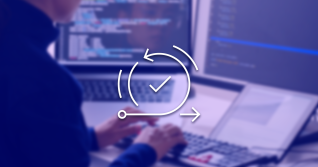On March 14, 2020, Tangram Vision CEO Brandon Minor flew from Colorado into the Bay Area to meet with COO Adam Rodnitzky. The two had just launched Tangram Vision, the company they co-founded to make sensors simpler for robotics, drones, and autonomous vehicles. Their plan was to, each month, alternate working at each other's location. However, that week, the Covid-19 pandemic lockdown began, forcing them to scrap that plan and figure out how to successfully collaborate from afar.
“We didn’t see each other in person again for a very long time. That kicked off our remote work experience,” Minor says.
The Tangram Vision engineering team started using GitLab's DevOps platform, which enabled them to work together without missing a beat. “GitLab was a key tool that allowed us to work really fluidly in a remote context,” says Minor. “Our engineering team has placed GitLab at the core of our remote workflow because it reinforces our values and perspectives around working well remotely.”
The Tangram Vision Platform takes care of complex perception tasks like sensor fusion, calibration, and diagnostics built on a scalable data backend that allows engineers to track, optimize, and analyze every sensor in their fleet. Tangram Vision’s SDK includes tools for rapid sensor integration, multi-sensor calibration, and sensor stability, saving robotics engineers months of engineering time.
Supporting complex collaboration
Perception systems are notoriously hard to get up and running and then maintain over time because of important lower-level activities like sensor integration and calibration. “We make sure all the sensors' data is running smoothly, everything's working together perfectly to basically a plug-and-play level. And then we enable the developers working on top of that to monitor and correct their system over time,” Minor says.
Tangram Vision has just launched a user hub that functions as a centralized sensor data center. The user hub joins their multi-sensor calibration module, as well as a multiplexing module that maintains stream reliability for all connected sensors. Developers can access a starter set of perception development tools (Tangram Vision Platform - Basic), which will be available on an open-source hub. Much of the initial user feedback will come through and be managed within repositories hosted on GitLab, both public and private, Minor says.
GitLab as a core for code
The engineering team has evaluated other platforms, according to Greg Schafer, senior web architect. “We’ve looked around but we've been very turned off by them for one reason or another. We really haven't swayed in wanting to use GitLab as our core for code,” Schafer says.
The team uses GitLab to manage branches and merge requests (MRs), boosting efficiency and control. “We were having a bit of a struggle early on managing the short-term flow. It was hard to put down tasks to paper. So, I dove deep into GitLab to see how it could help us there. And now that's what we use. GitLab is my product management tool,” Minor says.
The alternative, siphoning MRs into tools like Notion and Slack, would have been too cumbersome. “Having code-focused discussions in those places would've been very awkward vs. our current orientation of having those discussions in GitLab. Having that history of MRs and threads has been very useful,” Schafer says.
Doing all of the code reviews in the MR itself builds a paper trail of documentation for the future. That means the team can look back at exactly when a change was introduced and find any discussion about potential trade-offs next to a change. This gives the engineers confidence in understanding the context behind a change months or years after it has been introduced. “It encourages team members to be able to work asynchronously, as that context is not held in any single individual’s head but instead written and made explicit,” Minor says.
A host of features and options in GitLab
For Rodnitzky, what stands out about GitLab is that it has a host of features and options in one place. “It’s not just hosting code and MRs and all those discussions and things around that, but also the [continuous integration/continuous delivery], having that tightly integrated is really helpful,” he says. For example, there are different types of reports that might show up on the MRs. GitLab makes it easy to reference different CI steps in the MRs.
“You're not jumping to different websites or services to do that. It’s all in one place, which is super helpful,” he says.
Minor agrees, and adds, “The amount of oversight I have into every process going on, the transparency that gives me as a product manager to make the next decision has been invaluable.”
It’s not a stretch to say the transparency enabled by GitLab is reflected in Tangram Vision’s business model. “We’re transparent with our customers and developers,” says Minor. “There are a couple of morsels of code that will be private for a while, but, for the most part, the mission of the company is to make any engineer a computer vision engineer. To do that, a lot of education and openness is required. That’s already part of our culture.”



